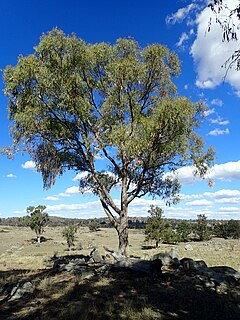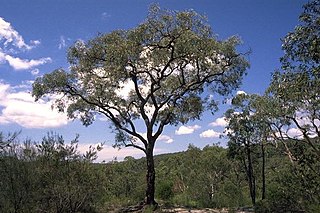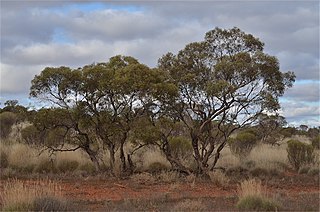
Eucalyptus coolabah, commonly known as coolibah or coolabah, is a species of tree and is found in eastern inland Australia. It has rough bark on part or all of the trunk, smooth powdery cream to pink bark above, lance-shaped to curved adult leaves, flower buds in groups of seven and hemispherical or conical fruit.

Eucalyptus dives, commonly known as the broad-leaved peppermint or blue peppermint, is a species of tree that is endemic to south-eastern Australia. It has rough, finely fibrous bark on the trunk and larger branches, smooth bark above, lance-shaped or curved adult leaves, flower buds in groups of eleven or more, white flowers and cup-shaped, hemispherical or conical fruit.

Eucalyptus nicholii, commonly known as the narrow-leaved black peppermint or willow peppermint, is a species of small to medium-sized tree that is endemic to New South Wales. It has thick, rough, fibrous bark on the trunk and branches, small, narrow adult leaves, flower buds arranged in groups of seven, white flowers and small, hemispherical, bell-shaped or conical fruit.

Eucalyptus nova-anglica, commonly known as the New England peppermint or black peppermint, is a species of small to medium-sized tree endemic to eastern Australia. It has thick, rough, fibrous bark on the trunk and larger branches, lance-shaped adult leaves, flower buds in groups of seven, white flowers and hemispherical or conical fruit.

Eucalyptus largiflorens, or black box, is a tree that is endemic to Australia. It has rough, fibrous or flaky bark, dull greenish-grey, lance-shaped leaves, oval to club-shaped green to yellow flower buds, white flowers and hemispherical, cup-shaped or barrel-shaped fruit.

Eucalyptus woollsiana is a species of tree that is endemic to eastern Australia. It has rough, fibrous bark on the trunk, smooth bark above, lance-shaped adult leaves, flower buds in groups of five or seven, white flowers and cup-shaped fruit.

Eucalyptus squamosa, commonly known as scaly bark, is a species of small to medium-sized tree that is endemic to the Sydney region in New South Wales. It has rough, tessellated, fibrous or flaky bark, lance-shaped or curved adult leaves, flower buds in groups of seven, nine or eleven, white flowers and cup-shaped or hemispherical fruit.

Eucalyptus aromaphloia, commonly known as Creswick apple-box, scented bark or scent-bark, is a species of plant in the myrtle family that is endemic to Victoria. It is a tree with rough, densely fibrous bark on the trunk and branches, lance-shaped or curved adult leaves, oval to spindle-shaped flower buds in groups of seven, white flowers and conical to hemispherical fruit.

Eucalyptus consideniana, commonly known as yertchuk, is a species of plant in the myrtle family and is endemic to south-eastern Australia. It is a tree with rough, fibrous, sometimes prickly bark on the trunk and larger branches, smooth grey bark above, lance-shaped or curved adult leaves, flower buds in groups of between eleven and nineteen, white flowers and conical to hemispherical fruit.
Eucalyptus croajingolensis, commonly known as the East Gippsland peppermint or Gippsland peppermint, is a species of tree that is endemic to southeastern Australia. It has rough, short-fibrous bark on the trunk and larger branches, sometimes smooth bark on the thinner branches, lance-shaped to curved adult leaves, flower buds in groups of nine or more, white flowers and hemispherical to cup-shaped fruit.
Eucalyptus ignorabilis is a species of small to medium-sized tree that is endemic to southeastern Australia. It has rough, fibrous bark on the trunk and branches, lance-shaped to curved adult leaves, flower buds in groups of seven, white flowers and cup-shaped to hemispherical fruit. It is found in far southeastern New South Wales and eastern Victoria.

Eucalyptus intertexta, commonly known as inland red box, western red box, gum coolibah or the bastard coolibah, is a species of tree that is endemic to central Australia. It has rough, fibrous or flaky bark on the base of the trunk, smooth white to brownish bark above, lance-shaped adult leaves, flower buds in groups of seven on the ends of branchlets, white flowers and cup-shaped to hemispherical fruit.

Eucalyptus malacoxylon, commonly known as Moonbi apple box or apple box, is a species of small to medium-sized tree that is endemic to a restricted area of New South Wales. It has rough, fibrous or flaky bark on the trunk and larger branches, smooth bark on the thinnest branches, lance-shaped adult leaves, flower buds in groups of seven, white flowers and cup-shaped, conical or hemispherical fruit.

Eucalyptus morrisii, commonly known as grey mallee, is a species of mallee or straggly tree that is endemic to western New South Wales. It has rough, fibrous or flaky bark on some or all of the trunk, smooth greyish bark above, lance-shaped adult leaves, flower buds usually in groups of three, white flowers and conical or hemispherical fruit.

Eucalyptus nandewarica, commonly known as mallee red gum, is a species of tree or mallee that is endemic to a small area of western New South Wales. It has mostly smooth bark, lance-shaped adult leaves, flower buds in groups of three or seven, white flowers and cup-shaped or hemispherical fruit.

Eucalyptus rudderi, or Rudder's box, is a species of tree that is endemic to northern New South Wales. It has rough fibrous or flaky bark on the trunk and branches, lance-shaped adult leaves, flower buds in groups of seven, white flowers and barrel-shaped or hemispherical fruit.

Eucalyptus tenuipes, known as the narrow-leaved white mahogany, is a species of small tree that is endemic to Queensland. It has rough, fibrous bark, narrow lance-shaped leaves arranged in opposite pairs, flower buds in group of eleven to twenty, white flowers and spherical to hemispherical fruit.
Eucalyptus terrica is a species of small tree that is endemic to south-eastern Queensland. It has thin, rough, fibrous bark on the trunk and larger branches, smooth bark above, lance-shaped adult leaves, flower buds in groups of seven, white flowers and hemispherical fruit.

Eucalyptus willisii, also known as shining peppermint or promontory peppermint, is a species of small to medium-sized tree, sometimes a mallee that is endemic to Victoria, Australia. It has rough, fibrous bark on the trunk and branches, lance-shaped to curved adult leaves, flower buds in groups of eleven to twenty five, white flowers and cup-shaped or hemispherical fruit.

Eucalyptus socialis subsp. socialis, commonly known as the summer red mallee, is a subspecies of mallee that is endemic to inland south-eastern Australia. It usually has rough bark on the base of the trunk, smooth bark above, lance-shaped adult leaves, flower buds in groups of between seven and eleven, pale creamy white flowers and barrel-shaped to urn-shaped or spherical fruit.
















